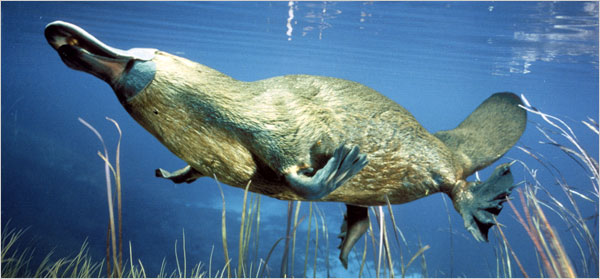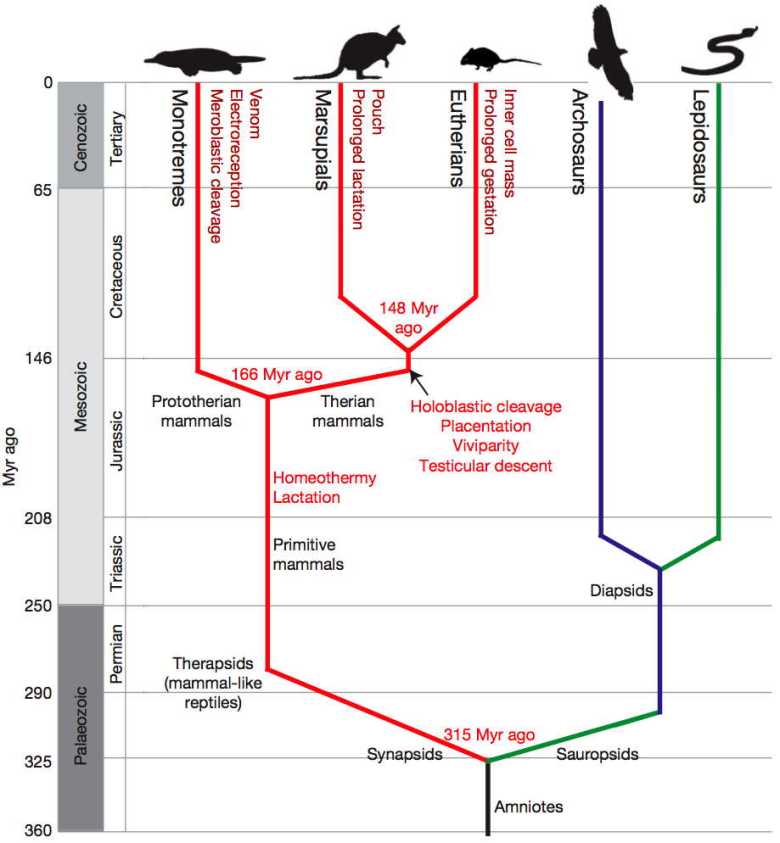And now we have to put up with newspapers calling the platypus “part bird.” PZ Myers at Pharyngula lets off a little steam in his intro to the platypus genome:
Over and over again, the newspaper lead is that the platypus is “weird” or “odd” or worse, they imply that the animal is a chimera — “the egg-laying critter is a genetic potpourri — part bird, part reptile and part lactating mammal”. No, no, no, a thousand times no; this is the wrong message. … What’s interesting about the platypus is that it belongs to a lineage that separated from ours approximately 166 million years ago, deep in the Mesozoic, and it has independently lost different elements of our last common ancestor, and by comparing bits, we can get a clearer picture of what the Jurassic mammals were like, and what we contemporary mammals have gained and lost genetically over the course of evolution.
Go over and read what the new platypus genome actually tells us about the course of evolution.
Here’s a diagram showing the evolutionary splits. PZ will explain it.
Diagram notes:
Emergence of traits along the mammalian lineage.
- Amniotes split into the sauropsids (leading to birds and reptiles) and synapsids (leading to mammal-like reptiles).
- These small early mammals developed hair, homeothermy and lactation (red lines).
- Monotremes diverged from the therian mammal lineage 166 Myr ago and developed a unique suite of characters (dark-red text).
- Therian mammals with common characters split into marsupials and eutherians around 148 Myr ago (dark-red text).
- Mammal lineages are in red; diapsid reptiles, shown as archosaurs (birds, crocodilians and dinosaurs), are in blue; and lepidosaurs (snakes, lizards and relatives) are in green.
- Geological eras and periods with relative times (Myr ago) are indicated on the left. Myr = “Megayear” or million years.
PZ writes:
This is a fairly conventional picture of our evolutionary history, and I have to emphasize that this paper reinforces the evolutionary explanation for the illustrated relationships.
Scientific logic, executive summary:
if we find a feature in birds that is also present in monotremes, marsupials, or eutherians, it is likely that that feature was also present in our Paleozoic common ancestor….
For instance, one of the unusual (for a mammal) features of the platypus is meroblastic cleavage…. the early [cell] divisions are incomplete — they produce a sheet of cells on top of the large yolk that are cytoplasmically continuous with the yolk cytoplasm…. Birds (archosaurs) and lizards and snakes (lepidosaurs) exhibit meroblastic cleavage. [In contrast, marsupials and eutherians, exhibit complete cleavage from the first division. So] meroblastic cleavage is likely to be a primitive character, one that was inherited from the last common ancestor of synapsids and sauropsids, over 300 million years ago.
Go on and read more: why the platypus isn’t “wierd,” how its venom evolved, what other animals are being sequenced—you know you want to.










